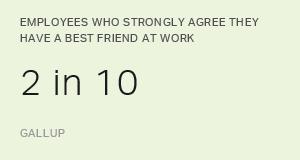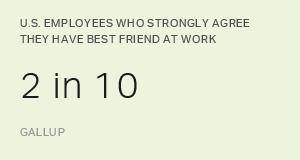Story Highlights
- Employees want more from their job than just a paycheck
- Work friendships increase productivity and engagement
- Culture determines whether friendships can naturally develop and thrive
I'm going to pose a question that is among the most controversial Gallup has asked in 30 years of employee engagement research:
"Do you have a best friend at work?"
When one of my Gallup colleagues first told me that the best friend item tended to elicit the strongest response from clients, I was surprised -- it seems like a clear-cut question without much basis for debate.
While I'm not alone in this thinking, I've learned that there are people who see a clear dividing line between work and home life. They may be friendly with their coworkers, but they don't consider them to be friends and certainly not best friends. I've also had my share of encounters with leaders and managers who expect their employees to leave their humanness at the door. They frown at chitchat and shared lunch breaks, and they view friendship as detrimental to productivity.
Typically, it's this group of leaders and managers who have the strongest reaction to the best friend item. Their reactions are varied -- some might chuckle or bristle at the language, while others may push back on the relevance of the item.
So, why does Gallup ask the best friend question?
The simple answer is performance. Our research has repeatedly shown a concrete link between having a best friend at work and the amount of effort employees expend in their job. For example, women who strongly agree they have a best friend at work are more than twice as likely to be engaged (63%) compared with the women who say otherwise (29%).
However, let's put the science aside for one moment and look more holistically at what's happening in the workforce. We now live and work in an era where many employees expect their job to be more than a paycheck. The paycheck still matters, of course, but employees seek out and stay with organizations that have exceptional workplace cultures. And while there are numerous components of these cultures, they are often characterized by overall feelings of trust, belongingness and inclusion.
We spend more of our waking hours at work than at home, and it's only natural that we want to build connections with our team members. We want work to feel worthwhile and having trusted confidants and supporters helps foster that feeling. We go to our work friends when we need to celebrate and commiserate about our personal and professional lives. In the absence of that outlet, work can seem lonely and isolating. It lacks attachments. We may like what we do, we may get to use our talents and strengths every day, but we're probably not feeling fully energized or motivated to put our whole selves into our roles.
What Women Say About Friendships at Work -- and Why You Should Listen
In the U.S., we've seen an unsettling trend of people in their "prime age" leaving the labor force. This development points back to numerous factors, including a widening skills gap and a loss of middle-class jobs. However, there is also a cultural component to labor force losses, especially when it comes to a specific group -- working mothers.
Many women who have children at home have decided that a traditional job no longer makes sense for them. It's not that they don't want to work, but corporate policies and systems make work impractical, if not unappealing for them. Why spend 40-plus hours away from your family every week just to lose the majority of your paycheck to childcare? Mothers have to weigh the pros and cons of working. Even those who truly enjoy their jobs can find it challenging to justify the time and sacrifice required to "make it" in many corporate cultures. This puts the onus on leaders to make it easier for working mothers to say "yes" to staying in the workforce.
Organizations that want to realize the benefits of a gender-diverse workforce are being tasked with finding ways to attract and retain women at all stages of life. Their strategies have to account for pay, promotion and performance management, but they must also account for culture including how they enable women to lead better lives. For most women, that includes having friendships at work. In our Women in America: Work and Life Well-Lived report, Gallup found that two-thirds of women say the social aspect of a job is a "major reason" why they work.
But it can be difficult for women to make connections at work. Our research also reveals that women in the workforce are less likely than women out of the workforce to be "thriving" in their social well-being (38% vs. 45%, respectively). Work can diminish a woman's ability to live what feels like a well-rounded and purposeful existence. When given a choice or if forced to make a choice, it's not surprising that an increasing number of women are saying goodbye to the labor force.
But Really, What About Performance?
Realistically, there are still leaders who will dismiss the talk about what women want most in a job and bring the conversation back to numbers and performance. They want proof that the best friend item actually impacts their bottom line.
Truth be told, Gallup wouldn't have included the item in our employee engagement survey if it didn't link to improved business outcomes. We've consistently found that for women and men having a best friend at work leads to better performance. For example, our employee engagement database shows that a mere two out of 10 U.S. employees strongly agree they have a best friend at work. Yet, by moving that ratio to six in 10, organizations could realize:
- 36% fewer safety incidents
- 7% more engaged customers
- 12% higher profit
When employees possess a deep sense of affiliation with their team members, they are driven to take positive actions that benefit the business -- actions they may not otherwise even consider if they did not have strong relationships with their coworkers.
Because the social aspect of work is so important to women, we also conducted a study comparing the behaviors and attitudes of women who strongly agree they have a best friend at work with those who do not strongly agree. We discovered that women who strongly agree with the item are:
- less likely to be actively looking or watching for job opportunities
- more connected with their coworkers, knowing what is expected of them and trusting their integrity and ethics
- more likely to rate their own, their team's and their organization's performance more excellently
- more likely to take risks that could lead to innovation
- more likely to have a positive experience during the day, such as enjoying what they do, making more progress and getting recognized for successes
- less likely to report having a negative experience during the day such as worry, stress and feeling tired
Having a best friend at work fuels greater performance. But before we go any further and make friendships at work the holy grail of engagement and performance, we need to bring some context to this conversation. Managers have to meet the basic engagement needs of their employees before they begin focusing on the friendship factor. For example, if employees don't know what's expected of them or don't have the opportunity to do what they do best every day, the friendships they do have at work are more likely to encourage gripe sessions. However, when basic engagement needs are met, friendships can take on a powerful dynamic in which casual, friendly banter turns into innovative discussions about how the team or organization can thrive.
On Board? Good. Here's What to Do Next:
Regardless of where managers fall with their team's engagement, organizations can and should be focusing on how they can dial into a culture of friendship and inclusion. The best employers recognize that people want to build meaningful connections. And for women specifically, friendships at work often help them answer the million-dollar question: "Is this job worth it?" However, for all employees, friendships at work speak to their greater well-being, engagement and performance.
We're not suggesting organizations force their employees to be friends. The takeaway is not to manufacture friendships or hit the gas on the best friend at work item. Rather, it's to create a culture where friendships can naturally develop and thrive. Below are three recommendations for fostering and supporting friendships within your organization:
1. Promote open communication and collaboration.
Communication and collaboration are cornerstones of an inclusive culture, and they provide a natural pathway to friendship. Employees have to believe they can speak up and share without fear of being shut down or shut out. Inviting everyone into the conversation creates a psychological safety net and cultivates feelings of trust and belongingness that inherently lend themselves to connection and friendship.
Leaders should develop communication channels that facilitate the free flow of ideas across the organization. They could, for example, host a forum on their company intranet that invites ideas on how to best reach strategic priorities or one that asks for ideas on how to improve the customer experience. Every month or quarter, leaders can choose a few ideas to explore -- ensuring they let the employee who shared the idea play a key role in the project and finding ways for a cross-section of employees to contribute.
Leaders should also recognize and celebrate the ideas that help strengthen the organization and its business. By giving employees and their ideas visibility, leadership grants everyone an opening to participate and collaborate, including those who work remotely.
2. Encourage people to get to know one another.
Many employees are involved in projects that encompass more than their immediate team members. Cross-functional or matrixed teams are the norm in an increasing number of organizations. When people and project managers correctly set the stage, this type of structure can lead to more opportunities for personal connections. Leaders have to set expectations for managers that their first responsibility is setting clear role expectations and consistently communicating with team members. But once they lay that groundwork, managers must ensure they are breaking down team silos and giving people openings to learn more about one another.
Leaders must also consider how they can help employees across the enterprise get to know each other. Again, they may look at how they use their intranet to share employee or team profiles. Or, they can also simultaneously help employees enhance their social and community well-being by providing opportunities for them to participate in philanthropic events during the workday. These types of activities can be beneficial to local communities and allow employees to meet and make connections with colleagues they may have otherwise never met.
3. Promote and participate in social activities.
Culture begins with leaders. They set the tone and are an example for employees through their actions. They make it acceptable or unacceptable for employees to become friends.
Nearly every company I've worked for or worked with has had some type of regular social activity for their employees, be it the annual holiday party or a summer picnic. But I don't always see leaders actively championing these events. Leaders must make it a priority to promote, attend and recognize company events so employees come to see socialization as the norm. Beyond the larger celebrations, leaders must also let employees see leaders taking lunch breaks together or visiting with managers and other employees. Small acts can make big impressions.
Women and men both have to see how a job fits into the greater picture of their lives, but perhaps more so among women. Culture is personal in many ways. It is personal to each organization, and it is personal to its employees. On the whole, women don't want to work in organizations where everyone avoids eye contact and stoically passes each other in the hall. The friendship factor influences an organization's ability to attract and retain a gender-diverse workforce. It also influences their ability to get the most out of their people. The best friend item is not a soft or oddball question, but one that directly impacts performance. It speaks to why people work and why they choose to keep working for you.
Learn more about how Gallup can help your organization improve performance with a focus on engagement and inclusion:
- Partner with Gallup to create a more inclusive culture.
- Learn more about the importance of employee engagement.
Amy Adkins contributed to the writing of this article.




